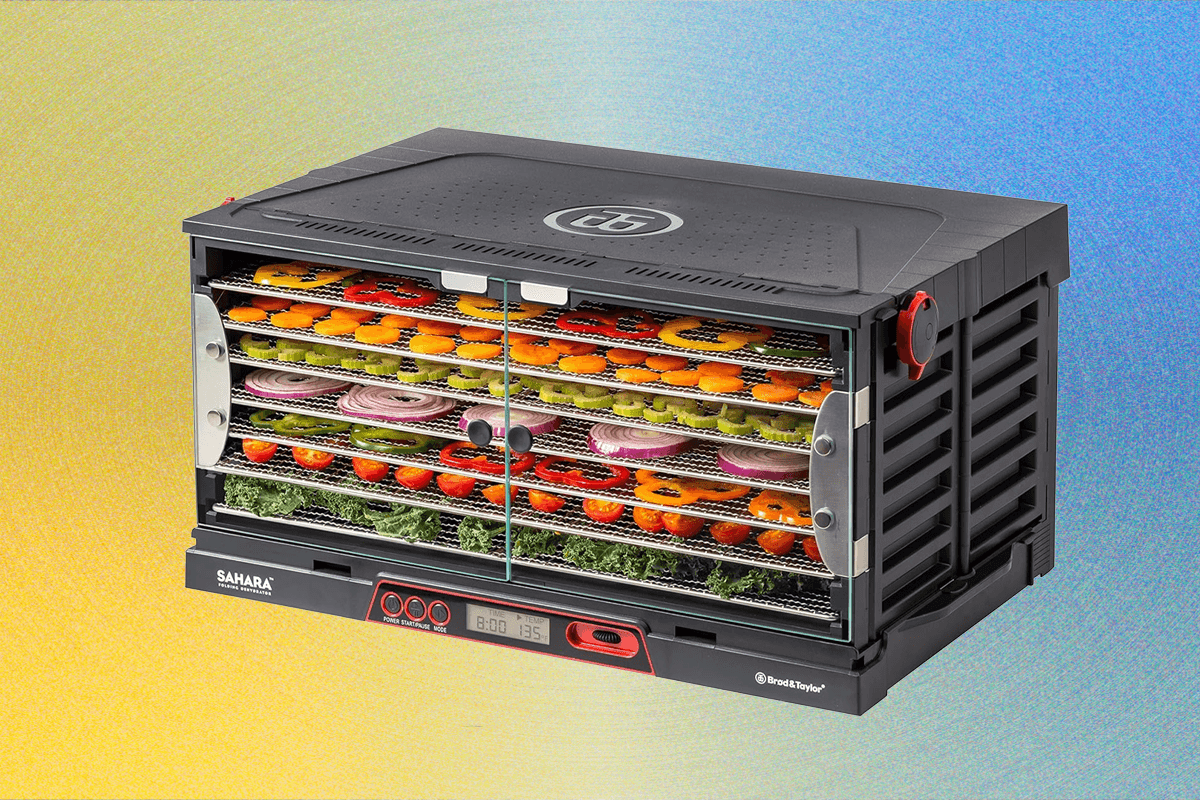All products featured on WIRED are independently selected by our editors. However, we may receive compensation from retailers and/or from purchases of products through these links.
I’ve been food dehydrator-curious for longer than I can remember. I knew some fellow mushroom foragers had these mysterious and bulky-looking appliances, but I never looked into owning one until I tried to dry sliced sweet potatoes in my gas oven. Not only did using my stove at its lowest setting for hours produce indoor air pollution, but I was unable to set my gas stove below 170 degrees Fahrenheit. My efforts produced burnt versions of the dried sweet potato slices sold as my dog’s overpriced treats. I also wanted to make beef jerky and dry flower petals, those glossy lemon and orange citrus rings for cocktails, potato chips, and fruit leather, and develop my own dehydrated meals for camping, since they are so expensive to buy.
I had been reluctant to buy a dehydrator because I live in a New York City apartment. I vet appliances on a basic formula of the amount of counter space the appliance would take up multiplied by how often I would use said appliance. Lack of counter space is why I don’t own an air fryer or bread machine. And so testing food dehydrators was a bit of a dream assignment and the perfect excuse to see if owning one was worth it. Spoiler alert: They are. Especially our top pick—Brod & Taylor’s Sahara Folding Food Dehydrator ($295).
For more useful appliance advice, check out some of our other kitchen-related guides, including Best Air Fryers, Best Toaster Ovens, and Best Espresso Machines.
July 2025 update: We’ve added the Breville Smart Oven Air Fryer Pro, Excalibur DH08SCSS13, Café Couture, and Elite Gourmet EFD329WD, and Dehytray Solar Dehydrator as picks, and ensured accuracy of links and prices.
-
Best Overall
The compactable Sahara by Brod & Taylor didn’t require a smoke-out (see above) and is the only model that came with a washable air filter to keep contaminants out of the dehydrator. The Sahara is billed as the “world’s first folding dehydrator,” made by a company known for its high-end folding bread proofer and slow cooker. If you’ve ever spent time with a King Arthur Baking Company catalog, then you’ve seen Brod & Taylor’s work; it makes sense that they’ve also created the Sahara.
The Sahara takes up the most kitchen counter real estate of all the dehydrators tested, but it’s made to collapse down to one-third the size when not in use. Brod & Taylor sells a carrying case ($60) to keep it tidy for storage. After my initial assembly of the Sahara, I know I can pop it up and have it ready to use in under four minutes. And it’s idiot-proof; even the power cord has its own slot.
Another feature of the Sahara is the ability to program dual time and temperature controls. There is a Time 1 and Time 2 along with a Temp 1 and Temp 2. The feature enables users to set, say, a short time at a high temperature and then a longer time with a lower temperature. The desire to have a small dehydrator in a small kitchen results in a tiny amount of drying rack space. The Sahara solves that problem in its ability to fold away while also providing the largest rack area of any dehydrator in this roundup. And while the Sahara doesn’t have an interior light, the large front glass panel makes it easy to view the dehydrating progress. The Sahara also comes with a silicone drying rack that I’ve used for fruit leather. The Sahara was the most expensive model I tested, but it’s also the one I most highly recommend. It has the most features and a robust warranty, making it a solid investment.
Specs Drying tray space 1,584 square inches Counter space (closed) 22″ x 12.25″ x 3.75″ Weight dehydrator, 12.8 pounds; stainless steel shelves, 4.9 pounds Temperature range 85–165 degrees Fahrenheit Timer 15 minutes to 99 hours Appearance Blade Runner dehydrator Warranty 3 years -
Easiest to Use
This Nesco is easy to use and is the only model I tested that had a light—this is an important feature, as much of dehydrating food is checking to see if it’s done. The larger fan makes a steady, almost white-noise hum. At 17 pounds, the Nesco’s large profile takes up space. Its seven trays provide ideal drying space for large batches. And like all the models tested in this roundup, it has programmable time and temperature. Its large window makes the drying progress easier to view than Nesco’s smaller Snackmaster Jr.
The control panels were intuitive and easy to use. And while this Nesco is a real presence on any kitchen counter, reminiscent of a mini wine fridge, it’s out of proportion for my city kitchen—it would be an ideal appliance in a large kitchen or dedicated pantry. Its large capacity makes an excellent addition for the home cook looking to expand their repertoire.
Specs Drying tray space Seven trays, surface area N/A Counter space (closed) 16″ x 14″ x 12″ Weight 17 pounds Temperature range 90–160 degrees Fahrenheit Timer 1 to 24 hours Appearance Mini wine fridge Warranty 1 year
-
Best Value
At $50, the Cosori is the best bang for your buck when it comes to dehydrators. It’s a workhorse that produced consistent results. Unlike the other models I tested that had their fan in the back, the Cosori’s fan is in the base. Even with the old-school setup of stackable rings, everything dried evenly. Still, there are some drawbacks. The Cosori uses BPA-free plastic ring trays that are bulky. And while they are top-shelf dishwasher safe, only a few can fit on the top shelf at a time. Also, the cylinder shape takes up more space than it should on a counter. It’s also an old-school white plastic.
The trays are stackable and can adjust to a wider width between trays, which comes in handy. I don’t love the plastic, even though it’s BPA-free. And because the dehydrator has an almost Lego-like design, the rings come apart if I don’t move the Cosori from its base. I also find cylindrical appliances challenging in terms of my kitchen-counter Tetris. And because I don’t love the old-school dehydrator look of the Cosori, I would want to store it. Fruit trays are sold separately, or you can cut parchment paper to fit the circular tray, though that seems a bit laborious. Still, the Cosori Pioneer does what it’s supposed to, and Cosori publishes some of the best dehydrated food recipes I’ve used. For the price, it’s an excellent first dehydrator.
Specs Drying tray space Five 11″ diameter trays with 1.1 pound capacity Counter space 12″ x 12″ x 9″ Weight N/A Temperature range 95–165 degrees Fahrenheit Timer 30 minutes to 48 hours Appearance Old-school white plastic Warranty 2 years -
Best Multitasker
Yes, it’s an air fryer (and not to be confused with the smaller Breville Smart Oven Air Fryer Compact), but the Breville Smart Oven Air Fryer Pro is a multitasker. It has the capacity to bake, toast, air fry, roast, and proof, along with dehydrating. And unlike the Cafe Couture below, Breville makes it very clear that the Smart Oven can dehydrate up to four trays at once, quadrupling its drying area to larger than many dedicated dehydrators. The Smart Oven takes up more counter space than the Cafe, making it a less attractive option for those with small kitchens. Still, for those who make pizza, love air frying, and need a dehydrator, this Breville might be for you.
I was able to fit the slices from two medium sweet potatoes into the Breville’s basket, and I set the temperature to 125 degrees Fahrenheit. It took about five hours to get the dried but pliable texture I was looking for. If I had cut the slices thinner, I would have achieved dry, snap-in-half chips. Breville’s display is easy to read and the front glass tray placement signage makes it almost idiot proof.
Specs Drying tray space 194 squre inches with one tray, 778 square inches with four trays Counter space (closed) 17.5″D x 21.5″W x 12.7″H Weight 30 lbs Temperature range 80–480 degrees Fahrenheit Timer Yes Appearance Stainless steel all business Warranty 2 years
-
Best Looking
This dehydrator was designed to be a permanent fixture on the counter. It’s as demure as dehydrators get with its petite profile, magnetic door, and four tiny mesh trays. Nesco made this model to make “fresh snacks that last one or two people a few days,” and it does just that. Its navy blue retro design gives ’50s kitchen nostalgia. The control dials are simple to use, though it shows only the hour without minutes until it hits the 59-minute mark, which can be annoying.
And while the mesh metal trays can be washed in the top rack of a dishwasher, the surface area—less than 4 square feet—is too small for my efforts when it comes to the prep involved with dehydrator cooking. If I’m going to slice fruits or veggies with precision or go through the trouble of dry-rubbing or marinating meat for jerky, I’m going to make a good batch. One of the selling points of dehydrating food is that it extends the shelf life, so to have such a small space doesn’t make the Nesco ideal. If you’re looking to dry some herbs or really only want small batches of fruit, then for the price and looks alone this Nesco makes sense.
Specs Drying tray space Approx. 576 square inches Counter space (closed) 13.3″ × 13″ × 10″ Weight N/A Temperature range 95–175 degrees Fahrenheit Timer 1 to 24 hours Appearance Nostalgic kitchen Warranty 1 year -
Best Capacity for the Price
Excalibur is the OG name in food dehydrators, known for its commercial and professional units. However, the company also makes a series of consumer dehydrators that offer large tray capacities at low prices. This eight-tray, 7.2-cubic-foot version has all the modern dehydrator features you’d expect—metal trays (though they’re not dishwasher-safe), mesh and fruit roll sheets, French doors, and a timer. You can also pause the time to add minutes if need be, and there’s a free digital recipe book (“Preserve it Naturally”) accessible via a QR code on the side.
I tested the Excalibur with fruit, tomatoes, beef, and marinated salmon, and it dried everything in nearly half the time than my old bargain-basement round Nesco Snackmaster. Best of all? The 600-watt motor is strong, but not loud—at all. I had it running in an open-concept kitchen/living room and clocked it at 40 decibels, which didn’t even require turning up the TV. I wish the warranty were a bit longer than one year, but this is still an extremely user-friendly dehydrator that just about any casual user would be happy with. —Kat Merck
Specs Drying tray space 1,037 square inches Counter space (closed) 17.32″ D x 13.39″ W x 14.08″ H Weight 16.5 lbs. Temperature range 85–165 degrees Fahrenheit Timer 30 minutes to 80 hours Appearance Mini commercial convection oven Warranty 1 year
-
Best for Those Who Want Fancy and Fast
As someone with a smaller kitchen and limited counter space, I was curious if there was a countertop oven that had a dehydrator mode. It would be nice not to pull an appliance from my storage closet when I want to dehydrate food. I also prefer appliances that have more than a single purpose. Enter the Cafe Couture Oven with Air Fryer. At 18.6 inches wide, the Cafe takes up only slightly more space than my old toaster oven. Among the 14 different cooking settings, the Cafe has a dedicated dehydrator function and uses the air fryer basket. Dehydrating food is all about air circulation and constant temperature.
And while I like the Cafe’s countertop dimensions, this is a drawback when it comes to drying area. While I couldn’t find the answer online, I do think I could buy a second and possibly a third basket and double or triple the dehydration area. And those extra trays might be worth it, as the Cafe was one of the fastest dehydrators I’ve tested. It is also WiFi compatible, though I’m not a fan of the SmartHQ app and wish bigger companies like GE would make appliance-dedicated apps.
Specs Drying tray space 156 square inches Counter space (closed) 12.5” diameter, 6” compact, 10.5” full size Weight 36 lb Temperature range 80–450 degrees Fahrenheit Timer Yes Appearance High-end polished kitchen Warranty 1 year -
Best for Small Spaces and Budgets
-
Photograph: Lisa Wood Shapiro
-
Photograph: Lisa Wood Shapiro
Elite Gourmet
EFD329WD Digital Food Dehydrator
I was looking for a collapsible dehydrator at a lower price point than the Brod & Taylor Sahara Folding Food Dehydrator, above, and the $43 Elite Gourmet Digital Food Dehydrator is an ideal option for those with small spaces on a budget. Its trays nest into each other, compacting to a little over 6 inches tall, and expands to just over 10 inches when all five trays are assembled. The machine is 12.5 inches in diameter, about the size of a vinyl record. The trays are dishwasher safe, but the dehydrator does not come with fruit leather mats—those need to be purchased separately.
The base-mounted fan and heater blow warm air upward. And I did notice the food in the trays closer to the base dried out a bit more than the upper trays. Still, I was able to dry two thin-sliced, medium-sized sweet potatoes at 131 degrees Fahrenheit in about six hours to achieve dry but slightly pliable chips. The light-up display is easy to read and it automatically alternates between time left and temperature when it’s in drying mode.
Specs Drying tray space 410 square inches Counter space (closed) 12.5” diameter, 6” compact, 10.5” full size Weight 5.29 lb Temperature range 95–158 degrees Fahrenheit Timer Yes Appearance Plastic utilitarian Warranty 1 year -
-
Best for Back-to-the-Land Lovers
The Dehytray from JUA Technologies is a solar-powered dehydrator. It’s the brainchild of two Purdue University professors who wanted to make it possible for small farmers/households across the world to have access shelf-stable food. As a city dweller, I’ve looked with envy at the DIY solar dehydrators that usually involve glass, wood, and a mirror. The Dehytray is bulky but lightweight. I brought it on a recent girls’ weekend out in the Hamptons where I knew I would have space and constant sunlight, something I can’t guarantee on my Brooklyn fire escape. At 33” long and 16” wide, the Dehytray has a significant amount of food-drying real estate.
Once I was finished pulling the protective blue wrappers off the acrylic sheets, I snapped everything in place and looked for a spot that had all-day sun. I cut up sweet potatoes, but wasn’t sure how long it would take to dry the slices into the stiff, slightly pliable chips my dog loves as treats. I started around noon and left the Dehytray out till dusk. I picked up the entire unit and brought it inside. The next morning, I returned the Dehytray to its spot in the sun. After about a total of eight hours and change, the sweet potato slices had shrunk and stiffened. They were done. There was little cleanup other than wiping down the tray. And while JUA says I can dry fruits and even meats in the Dehytray, I worried about insects or critters, as this is an outdoor product. I wouldn’t attempt to dry fruit leather in the Dehytray, but I could see doing vegetables and herbs. You can even buy additional trays and stack them for drying. At $99, this would be ideal for the home gardener.
Specs Drying tray space 528 square inches Counter space (closed) 33”L × 16”W × 5” H Weight 5 lbs. Temperature range Solar powered Timer When the sun’s up Appearance Garden equipment Warranty 90 days -
Best for Those in a Hurry
The Magic Mill has both fast and raw modes. And its double-time fast mode did dry apple slices, banana chips, and kiwis in about half the time of when I ran the dehydrator at regular speed one day. While I liked the large viewing window, the Magic Mill doesn’t have an interior light, so I had to pull out the trays to check their progress from time to time, as I couldn’t clearly see how the items were doing.
While the Pro has a smaller footprint than the Nesco seven-tray, it still takes up a significant amount of counter space, depending on your kitchen’s size. The fan is quieter than other models I tested, and its stainless steel trays are dishwasher safe.
Specs Drying tray space Seven 11″ x 10″ trays with 8 pound capacity Counter space (closed) 15.5″ x 11.5″ x 10.75″ Weight 13.75 pounds Temperature range 95–167 degrees Fahrenheit Timer 30 minutes to 24 hours Appearance Modern stainless steel Warranty 1 year
What to Know Before Buying
All dehydrators were tested with the same ingredients with similar results in drying times, mouthfeel, and taste. And all but the Sahara required at least 30 minutes of “smoke out” prior to the first use to rid the dehydrator of factory fumes. The manufacturer manuals suggested doing this in a well-ventilated space. I ended up using my deck for several of the models, as I didn’t want those fumes in the house.
I was most excited to make beef jerky in the dehydrators, but be aware that USDA safe food handling rules include cooking the meat to an internal temperature of 160 degrees Fahrenheit before dehydrating, a process to avoid foodborne illness. I used this method for my first foray into making beef jerky. And it’s that extra safety step that produced a less-than-appealing mouthfeel. While I’m not advocating that anyone skip that initial cooking step, this recipe from Brod & Taylor does the cooking in the brand’s dehydrators at 165 degrees Fahrenheit; most recipes I’ve looked at online or in the vast world of dehydrator TikTok skip the precooking step. The best beef jerky hack I learned was from a creator who bought presliced meat meant for Korean barbecue and dry-cured it with a rub. The very online world of dehydrator cooking has endless recipes and tips.
Manage your expectations: Consumer dehydrators cannot always produce the results achieved by commercial freeze-drying. Some of the end products of dehydrator “cooking” surprised me. Some fruits and veggies stayed pliable, while others were brittle, with a satisfying crunch. There is a bit of trial and error with slice size and timing. Each time I use the dehydrator, I get better at prep and timing.
Lastly, as you enter the crisp world of dehydration, know that ambient humidity and the amount of water in your food will impact drying times. In other words, what took eight hours in August in Maine might take less time in Brooklyn in September.
Food dehydrators took my cooking to a third dimension. In testing the five models reviewed here, I made beef jerky; dried apple, kiwi, strawberry, and banana slices; blueberry chia seed fruit leather; sweet potato chips; dehydrated green beans, peppers, and carrots; and bright pink dried rose petals. There is trial and error. The thing I noticed was that it’s best to err on the side of longer dehydrator times. I run the dehydrator overnight for 12 hours. I used the Awair Element, the PurpleAir Touch Indoor, and the QP Pro air quality monitors to see how the dehydrators impacted my indoor air. Unlike my gas oven, the food dehydrators did not impact my indoor air quality, even while making beef jerky
Power up with unlimited access to WIRED. Get best-in-class reporting that’s too important to ignore for just $2.50 $1 per month for 1 year. Includes unlimited digital access and exclusive subscriber-only content. Subscribe Today.


.jpg)
-Offwhite-Background-SOURCE-Amazon.jpg)
.jpg)

.jpg)



.jpg)


